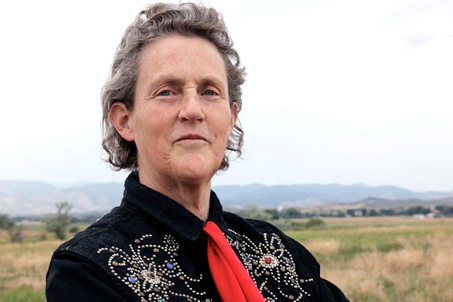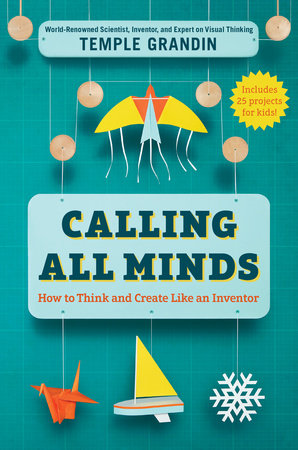Inventor and Autism Spokesperson Temple Grandin to Speak at Children’s Institute
- By Liz Button
Temple Grandin — scientist, inventor, engineer, autism spokesperson, and author of the forthcoming children’s book Calling All Minds: How to Think and Create Like an Inventor (Philomel, May 15) — will be one of four keynote speakers at the American Booksellers Association’s sixth annual ABC Children’s Institute, to be held June 19–21 in New Orleans.

Children’s Institute will also feature keynote speeches by Chelsea Clinton, Angie Thomas, and Mallika Chopra; educational sessions for booksellers on a range of topics; and networking events, author receptions, and parties.
Grandin is a professor of animal science at Colorado State University and has written numerous books on autism, including the classic Thinking in Pictures (Vintage) and the New York Times bestsellers Animals in Translation (Scribner) and Animals Make Us Human (Houghton Mifflin Harcourt). In 2006, HBO made an Emmy Award-winning movie about her life, and in 2016, Grandin was inducted into the American Academy of Arts and Sciences.
Calling All Minds is a book of personal stories, inventions, and facts that will thrill curious kids while providing a glimpse into Grandin’s own past as a young inventor. Its pages include more than 20 of her personal childhood experiments, such as making a kaleidoscope, constructing a kite, and fashioning a pair of stilts, all of which come with step-by-step instructions so kids can recreate them.

Grandin’s book not only delves into the scientific questions behind the inventions — What makes a kite fly? What makes a boat float? Why are snowflakes symmetrical? Why do golf balls have dimples? — but teaches young inventors the value of tinkering, fiddling, and maintaining an open and inquisitive mind.
Here, Bookselling This Week speaks with Grandin about her new book and why children need more hands-on projects.
Bookselling This Week: Why did you decide to write this book? What can it teach children?
Temple Grandin: Kids need to be doing more hands-on things. I think a lot of the hands-on projects that are in there are going to require a lot of tinkering to get them to work, and many kids today don’t even know how to draw circles with a compass or cut out a paper snowflake. We need to get kids doing more physical stuff.
Also, I think what’s interesting in the book is the explanation of how patents work. Patents basically served two functions originally: one was to store knowledge and the other was to give the inventor a certain amount of time where they could profit from their invention. The book also has a lot of fun stuff for kids to do, like recreating some of the things that I designed when I was a kid.
BTW: When you were writing Calling All Minds, did you try to recreate the experiments that you originally conducted as a child?
TG: The main ones we recreated were the optical illusion room, the parachute, the bird kite, and the helicopter. I made the paper snowflakes, the paper airplanes; I even drew some flowers with a compass. We have kids today who don’t even know what a compass or a protractor is. When my livestock students have to use one to do a drawing, we’re having to explain what a compass is. You have a lot of students growing up today who are totally separated from the world of practical things.
BTW: Do you think kids’ estrangement from the world of practical things has to do with the inescapabilty of today’s digital world?
TG: I don’t think it can be totally blamed on that. One of the biggest things I’m going to blame it on is schools taking the hands-on stuff out of their curriculum, like arts and crafts, cooking, sewing, woodworking, auto shop, and metalworking. There are also very few homemade Halloween costumes these days. When I was a child, we made our costumes out of old bedsheets and cardboard and whatever we could find.
The other thing kids are going to learn from this book is that practical things don’t always work. You do a hands-on chemistry experiment in class, but they don’t always work out. That’s the practical world. And I think a lot of kids don’t understand that. Nothing in the practical world is ever going to be perfect.
BTW: What would you tell children’s booksellers about hand-selling Calling All Minds?
TG: It does three things: it introduces a lot of famous inventors of common things and their histories, and I made sure there were female inventors in there and inventors of color, too; it introduces the idea of patents and what they are; and it has instructions for doing experiments and making things. Kids are going to have to tinker and experiment to get things to work.
BTW: Do you think bookstore owners could do some of these experiments in their stores with kids who come in?
TG: Yes, certainly, some of them they could: cutting out paper snowflakes, drawing flowers with compasses, making the helicopter, making the trapezoidal window. The optical illusion room you could make out of book boxes — there are plenty of those in a bookstore. It’s all just paper and cardboard and little cheap things people can get anywhere; there’s nothing expensive in it. Though some of the more complex ones, like the kaleidoscope, you might not be able to do. And flying things, I’d recommend not doing in a bookstore.
BTW: What will your talk be about at Children’s Institute?
TG: I’ll be talking about how when I was a child I loved inventors. My grandfather was one of the co-inventors of the autopilot for airplanes, and he worked in a loft with two other people to figure out how to make the coils work that set the position of the plane. My grandfather had to tinker and tinker and tinker to get the autopilot to work. We need to get kids to tinker.
I’ll talk about the fact that there are a lot of kids who are kind of quirky and different — Thomas Edison was labeled a hyperactive high school dropout, but he could build anything. I have a PowerPoint presentation I’ve prepared, and it’s going to have a whole section on airplane wingtips.
BTW: What were your favorite books as a child?
TG: There was this book I loved on famous inventors: it had Thomas Edison; Elias Howe, who invented the sewing machine; Cyrus McCormick, who invented the reaper; Robert Fulton, who invented the steamboat — the telegraph, the telephone, those big inventions were all in there. I also loved Black Beauty and The Wizard of Oz. I read all the Oz books when I was in elementary school.

